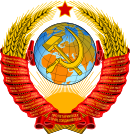
Back الإسلام في الاتحاد السوفيتي Arabic СССР-ҙа ислам Bashkir Islam a la Unió Soviètica Catalan Islam en la Unión Soviética Spanish Islam Neuvostoliitossa Finnish Islam di Uni Soviet ID Islam di Kesatuan Soviet Malay Ислам в СССР Russian Sovyetler Birliği'nde İslam Turkish سوویت اتحاد میں اسلام Urdu
| Part of a series on the |
| Culture of the Soviet Union |
|---|
 |
| People |
| Languages |
| Traditions |
| Cuisine |
| Festivals |
| Literature |
| Music |
| Sport |
| Islam by country |
|---|
 |
|
|

After it was established on most of the territory of the Russian Empire, the Soviet Union remained the world's largest country until it was dissolved in 1991. It covered a large part of Eastern Europe while also spanning the entirety of the Caucasus, Central Asia, and Northern Asia. During this time, Islam was the country's second-largest religion; 90% of Muslims in the Soviet Union were adherents of Sunni Islam, with only around 10% adhering to Shia Islam. Excluding the Azerbaijan SSR, which had a Shia-majority population, all of the Muslim-majority Union Republics had Sunni-majority populations.[1] In total, six Union Republics had Muslim-majority populations: the Azerbaijan SSR, the Kazakh SSR, the Kyrgyz SSR, the Tajik SSR, the Turkmen SSR, and the Uzbek SSR.[2] There was also a large Muslim population across Volga–Ural and in the northern Caucasian regions of the Russian SFSR. Across Siberia, Muslims accounted for a significant proportion of the population, predominantly through the presence of Tatars.[2] Many autonomous republics like the Karakalpak ASSR, the Chechen-Ingush ASSR, the Bashkir ASSR and others also had Muslim majorities.
Following their seizure of power, the Bolsheviks wanted to include as much territory of the former Russian Empire as possible into the nascent Soviet Union. However, they experienced difficulties during their attempts to impose communism within regions that had been under traditionalist Islamic influence for centuries (i.e., onto the Turkic peoples). While the communist state actively pursued a policy of state atheism, Soviet authorities allowed limited religious activities to continue in the six Muslim-majority Union Republics.[3] Mosques operated in most large cities within these territories, though their numbers decreased dramatically; there were 25,000 mosques across the Russian Empire at the time of the Bolshevik Revolution in 1917, and only 500 mosques across the Soviet Union in the 1970s.[4]
In 1989, as part of new Soviet policies that relaxed religious restrictions throughout the country, a number of new Muslim associations were formed and many of the mosques that had been closed by the government were reopened. The Soviet government also announced plans to permit the education of a limited number of imams in the cities of Ufa and Baku.
In the years leading up to the dissolution of the Soviet Union, between 45 and 50 million Soviet citizens identified as Muslims, though only around 500 mosques were in operation across the country. Islam was prosecuted[5] and Soviet law forbade all Islamic religious activities outside of mosques and madrasas. All Islamic religious facilities were supervised by four "Spiritual Directorates" established by the Soviet government in order to provide oversight. Sunni Muslims were overseen by the Spiritual Directorate for Central Asia and Kazakhstan, the Spiritual Directorate for the European Soviet Union and Siberia, and the Spiritual Directorate for the Northern Caucasus and Dagestan. Shia Muslims were overseen by the Spiritual Directorate for Transcaucasia, though this establishment served Sunni Muslims as well.
- ^ "Soviet Union - Muslim". Retrieved 25 August 2016.
- ^ a b Hannah, Abdul. "Chapter 1." Early History of Spread of Islam in (former) Soviet Union. 16 Sep 2002. Witness Pioneer. 14 Feb 2007 [1]
- ^ "Soviet Union - POLICY TOWARD NATIONALITIES AND RELIGIONS IN PRACTICE". Retrieved 25 August 2016.
- ^ Eaton, Katherine Bliss (2004). Daily Life in the Soviet Union. Greenwood Publishing Group. p. 296. ISBN 978-0-313-31628-9.
- ^ Ginat, Rami. The Soviet Union and Egypt, 1945–1955. 2022. Taylor & Francis.